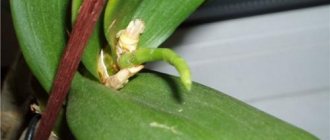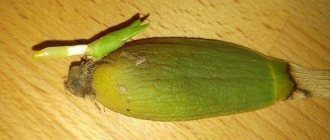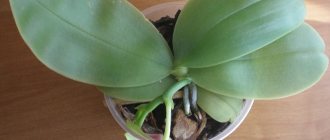Life cycle of a healthy plant
Observations show that the average flowering of an orchid lasts for about three months. This usually happens 2-3 times a year, with breaks for special dormant times, when the plant can rest and gain strength before flowering again.
If a healthy-looking orchid does not bloom, you should pay attention to the conditions of detention , because this is the main indicator of what is happening to your flower.
When is there cause for concern?
Usually blooming specimens are purchased at a flower shop.
In this case, they will drop their flowers in a couple of weeks or months. When will they bloom again and why is it taking so long? If adult orchids at home do not gain color after 1-1.5 years, then there is definitely cause for concern.
This time is enough for the adaptation period to end, and if the flower does not release an arrow, then something is going wrong in the life of the plant.
Possible problems
Doesn't grow
If the orchid seems to have frozen, it means that everyday life has become boring to it , all activity has come to naught. This means that it is necessary to invigorate it with the help of stress, which will resume all the stopped processes in the plant.
Only roots develop
To establish the reason for the lack of flowering, you need to know the basic rules of care and external signs of a healthy orchid.
Normally, the growing tips of the roots are bright light green in color . If they are not visible for several months, it is necessary to reconsider the care of the plant. For regular orchid flowering you need:
- a large amount of diffused light;
- in the autumn-winter period, daylight hours are extended to 12 hours using a special phytolamp.
Insufficient duration of lighting in winter is the main factor due to which an indoor orchid does not form a peduncle.
Produces new leaves, but no buds
Why does your orchid grow young leaves, but does not bloom well at home? Improper watering is the main reason why an orchid does not bloom and only leaves grow. Few people, when buying a beauty in a store, bother to read the care information. Tropics means damp. And every day they pour a large amount of liquid into the pot. This becomes the reason that the plant does not receive proper nutrition and ultimately does not live in its cycle. We talked in more detail about why your beauty does not bloom and what to do in this case in another article.
Reader Questions
How to avoid drying out and flooding the plant?
The orchid needs intensive watering only during the growing season and flowering :
- soft water with a low salt content is suitable for irrigation: melt water, rain water or ordinary water, settled after boiling;
- in summer, watering is carried out 2-3 times a week, in winter - every 10 days after the top layer of soil has dried out;
- the plant is placed for 10-15 minutes. into a basin of water or sprinkle generously from the shower;
- then they are placed on a special tray for half an hour to allow excess moisture to drain through the drainage holes.
Whether the plant needs watering will help determine the color of the roots: dry roots are silver-gray. If the roots have a greenish tint, it means they still contain moisture.
The plant on the left needs watering, the plant on the right does not.
How does an unpleasant neighborhood affect flowering?
The duration of an orchid’s flowering can be affected by many factors related to improper care of the orchid, as well as:
- fruits ripening next to the plant . Ethylene gas, which is emitted by apples, bananas and other fruits, as well as tomatoes and nuts, promotes premature ripening of buds and shedding of buds;
- tobacco smoke . The harm from tobacco smoke depends on the area of the room where people smoke, the number of people smoking and the number of cigarettes smoked. In a smoky room, the orchid will drop its flowers and may not bloom at all.
Orchids do not tolerate tobacco smoke and drop flowers.
Eliminating unfavorable conditions will help restore the orchid to bloom.
What drugs will add energy to your orchid?
The use of biostimulants adds energy to the plant and stimulates the shoot.
Epin
The drug is a synthetic analogue of a natural phytohormone , an effective bioregulator and stimulant:
- increases the immunity and vitality of the plant;
- protects against stressful environmental influences;
- stimulates the growth and development of plants.
Epin stimulates all biochemical processes in cells , due to which the plant develops well and blooms regularly.
The solution for treatment is prepared using 7 drops of Epin per 200 ml of water. Spraying is carried out once a month from the beginning of spring until autumn. When the dormant period begins, treatment should be stopped.
succinic acid
This drug activates many biological processes in plants:
- strengthens the immune system;
- improves growth and development;
- stimulates the beginning of flowering and its duration.
A solution of succinic acid is used in different ways:
- wipe the leaves with a damp cloth soaked in an acid solution.
- once every 2-3 weeks, spray the leaves with a spray bottle;
- You can water the roots with the remaining solution.
After regular treatment, the plant forms new flower stalks, roots and leaves grow.
Why is there no flowering in apartment conditions?
The appearance of a plant can tell a lot about its health:
orchid roots are normally dense, silver-gray, when moistened they acquire a light green color;- young roots are bright green, old ones are muted;
- the leaves of a healthy plant are dense, green, with shiny skin without signs of wrinkling or drying out of the tips;
- rosette - a young leaf grows from a rosette on a vegetating plant.
All of this is to say that overall your orchid is completely healthy. But to understand exactly why your orchid is not blooming, you should pay attention to the details:
- If you notice that your beautiful inhabitant of the windowsill is not changing at all, you should watch it more closely; if observations prove that there is something wrong with the flower, although outwardly everything is in order, then it is necessary to take measures to bring the flower into an active state.
- The development of the root system is closely related to the state of the above-ground part of the orchid.
No matter how many aerial roots a plant has, it is necessary that they look healthy.By the appearance of the roots you can judge what the plant lacks:
- darkening of the roots is a sign of waterlogging and rotting;
the appearance of a large number of aerial roots – increased dryness in the room.
- The pot has good drainage, and excess liquid flows safely through the holes into the tray.
At the same time, it does not have time to wet the soil. It turns out that there was no watering as such. Drainage holes are clogged with soil and roots. It turns out to be a swamp. This is where the unfortunate orchid will survive for the time being. Then the roots will safely rot and the plant will die. So, in the case when you only observe the growth of leaves, pay attention to whether you are caring for it correctly and whether everything is enough for the plant to feel great.
We invite you to watch a video about the reasons why there is no flowering in indoor conditions:
Where can it appear?
Babies appear:
- from a dormant bud on a peduncle;
- on the stem;
- on the roots.
On the peduncle
Most often, the offspring appear on the peduncle. It will not be immediately clear to an inexperienced gardener that this is a shoot and not a future bud. The dormant bud comes to life, a tubercle appears on it - a sign of continued life or flowering. How to understand what exactly is happening? After about a week, a tiny leaf will become visible on the tubercle. Another couple of weeks and the second leaf will grow. The leaf blades copy the leaves of the mother flower.
On the stem
Forming a baby on a stem is not the best option. You will need maximum attention and care to raise offspring and preserve the life of an adult orchid.
This baby looks as if a small plant has sprouted right on the trunk of an adult orchid. The reason may be that the growth point has been lost. But the flower still strives to continue life and forms a new bush in an inappropriate place. Such a plant requires intensive care so that the young sprout can successfully form both leaves and the root system. It is important to wait until the baby is fully formed: only in this case, when separating it from the mother stem, you will not injure it too much.
Important! Immediately after the separation of the young seedling, the cut sites must be processed in order to preserve the adult orchid.
On the roots
The space between the roots is another place where sprouts can appear. In this case, it is difficult to make a mistake: the shoot looks like a fully formed plant, only very small in size.
Peculiarity! When a shoot develops on the roots, it is difficult to estimate the size of the root system of the shoot. It is necessary to periodically remove the top layer of soil in order to clearly see how much the roots have grown. The baby should be transplanted only when the length of its own roots is at least 5 cm.
On the leaf axils
Another place where babies often appear is in the leaf axils. Typically this process starts after flowering. After some time, the leaf dies because the baby bends it during development and does not provide enough space and nutrition. In this case, the principle of growing a baby is similar: we wait for the baby to “ripen” and form a high-quality root system, after which we can put it in a separate container.
How to restore normal flowering?
If your pet beauty has not bloomed for a long time, then you should definitely resort to helping her in this matter.
Often the reason why the usual flowering cycle is suspended is that the orchid has become accustomed to proper care and, directing all its energy to the growth of leaves and roots, “forgot” about the flowers. In this case , it is advisable to slightly “cheer up” the plant using a couple of simple options . One of which is placing the plant in a stressful state.
You should stop standard watering for a short period of time, causing a drought, so the plant will perk up and subsequently return to the normal flowering cycle.
There are many reasons why a beautiful orchid may stop blooming , but do not despair, because you can always find a way out, help improve the health of the plant so that it will continue to delight you with its marvelous color.
We invite you to watch a video on how to create stressful conditions for an orchid to bloom:
Read more about how to make an orchid bloom here.











